The Secret Games of St. Bride's

"The Games Mistresses" of St. Bride's were the mysterious team of writers responsible for 1980s British text adventure games such as the eponymous The Secret of St Brides, the joke-filled Very Big Cave Adventure, the crime-spoof Bugsy, and the deliberately controversial Jack the Ripper. The St. Bride's story, or as much as is known about it, has been told elsewhere. This article concerns some of their lesser-known games. Games that might have never seen the light of day...
Gordon Inglis and GI Games...
 |
(Above) Gordon Inglis in his GI Records days. |
At the end of 1991, four years after their last big commercial game, three new St. Bride's text adventures were released. These previously unpublished ZX Spectrum titles, Silverwolf, The White Feather Cloak, and The Dogboy, were distributed by the relatively obscure Scottish mail-order firm GI Games.
GI Games was owned by Gordon Inglis. In the 1970s and early 80s, Gordon had run the Edinburgh-based store (and mail order service) GI Records. After his record shop closed in the mid-1980s, Gordon turned to antiques, but through his mail order business, now called Sandven Ltd, he also started distributing computer software.
After he experimented running a second-hand software swap service and a ZX Spectrum public domain software library, he set up a new venture, which concentrated on re-releasing popular, but out of print titles such as the text adventures previously sold by Mike White's 8th Day, Fergus McNeill's Delta 4, and the games written by the ladies of St. Bride's.
Gordon had experience in making deals of this kind. In his GI Records days, he had reissued several hard-to-find albums from the 1960s and 1970s. His LPs were released in basic, no-frills packaging and his approach to computer games was similar. The simple, generic inlays kept costs low; a necessity if he was to cater for the now rapidly dwindling text adventure audience who were more used to budget-priced releases from homebrew labels such as Zenobi Software.
 |
 |
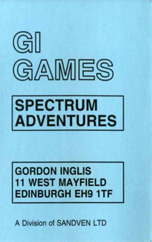 |
(Above: One of Gordon's GI Records reprints and examples of the simple GI Games packaging) |
||
For adventure fans at the time, it was great to have a way of legally obtaining some classic text adventures but what was interesting about the deal was the inclusion of three new, previously unpublished St. Bride's games. What was the history of these games? Why hadn't they been previously released? How did three titles from such a big name in adventure gaming come to be released by a small, independent publisher? There are still many unanswered questions, but here is what we know so far…
Silverwolf...
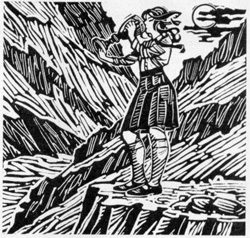 |
(Anthony Colbert's illustration for the Your Sinclair review of Silverwolf) |
Silverwolf was initially mentioned way back in December 1985; an article, in issue 45 of Sinclair User, vividly described the visit of some computer journalists to the St. Bride's School to view the team working on a batch of new games.
Silverwolf was one of those games. The original plan was that the software would be distributed together with a comic book. St. Bride's were still using Gilsoft's Quill and Illustrator at the time. The Sinclair User article mentions that the ladies thought that Silverwolf "might need an entirely new system for writing adventures". It seems that they were correct as the finished GI Games release was produced with the Professional Adventure Writer; the more powerful Gilsoft software that was released in early 1987.
(Update 3/6/21: This article, part of Aaron A. Reed's excellent 50 Years of Text Games series, looks a little deeper at Silverwolf's origins as a fantasy story, serialised in a 'St. Bride's publication', the Artemis 'zine circa 1983; see here and here.)
The game was never released by St. Bride's. It was presumed that, like other adventures announced by the company over the years (such as Raffles, Sir Jasper, Wondergirl and Alice) that Silverwolf was never completed, but the GI Games ZX Spectrum release proved that not only was it finished, but it was also incredibly polished.
Silverwolf is a well written and illustrated graphical text adventure, with clever puzzles and an interesting multiple-character mechanic. The game would likely have been regarded as a classic had it made it out earlier in the life of the ZX Spectrum. As it was, when it was eventually reviewed in the August 1992 issue of Your Sinclair it received a score of 9/10.
We know that St. Bride's planned to release the game on other formats, at some point, as Tim Gilberts of Gilsoft worked on the conversions for them but recalls that "they went bust before paying". The C64 version was completed, using Gilsoft's proprietary custom C64 PAW/Illustrator interpreter, and Tim has kindly shared the document he submitted back to St. Bride's, in February 1989, after finishing the port.
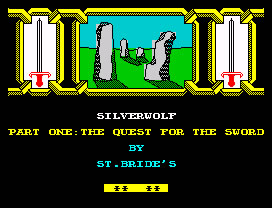 |
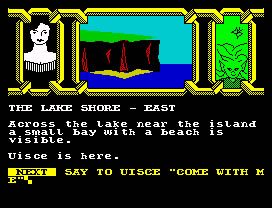 |
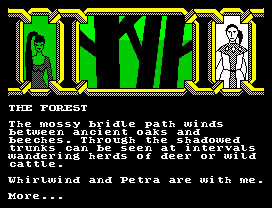 |
| (Above: Silverwolf made good use of the power of Gilsoft's Professional Adventure Writer) | ||
The White Feather Cloak and The Dogboy...
 What of the two other games; The White Feather Cloak, and The Dogboy? Well, their origins lie elsewhere...
What of the two other games; The White Feather Cloak, and The Dogboy? Well, their origins lie elsewhere...
Magazine articles from 1985 mention that author Marc Peirson, who was working for Beyond Software at the time, was writing the first part of a trilogy, The White Feather Cloak, for release by book publisher Dorling Kindersley; initially for the ZX Spectrum computer. A follow-up news piece, from a couple of years later, mentions that publication would now be through the Starlight label, run by former Beyond staffer Francis Lee, who had a publishing arrangement with Ariolasoft. A C64 version of the game is also listed in the PCW Show write-up in the December 1987 issue of Zzap! 64. The White Feather Cloak never appeared from either DK or Starlight.
 Francis Lee went on to found Destiny Software (in around November 1987) and a news piece from that time mentions the release of another game based on Marc Peirson's work, called King. The article lists the team at St. Bride's as the authors of the game. Mike Gerrard, reporting on the news in his Your Sinclair adventure column, said that he had seen the game a couple of years earlier, indicating that it might have been in the works for a while, possibly when Francis Lee was still running the previous Starlight imprint. In 1988, a potential C64 version of the game was namechecked in the pages of Zzap Italia (as spotted over at GTW).
Francis Lee went on to found Destiny Software (in around November 1987) and a news piece from that time mentions the release of another game based on Marc Peirson's work, called King. The article lists the team at St. Bride's as the authors of the game. Mike Gerrard, reporting on the news in his Your Sinclair adventure column, said that he had seen the game a couple of years earlier, indicating that it might have been in the works for a while, possibly when Francis Lee was still running the previous Starlight imprint. In 1988, a potential C64 version of the game was namechecked in the pages of Zzap Italia (as spotted over at GTW).
Somewhere along the line, before the game was released by GI Games, the title of King was changed to The Dogboy, matching the name of one of the characters in the story. Echoes of the earlier title is evident in the file names of the two parts of the game, which were labelled "K1" and "K2".
Marc Peirson...
The obvious person to approach to try and find some answers about the games was Marc Peirson, the author of the poems that they were based on. Marc (aka Mark Pearson) has gone on to become a playwright, award-winning scriptwriter, and novelist, but was still happy to talk about his early days in computer-related publishing when I contacted him in March 2021. Could he shed any light on the history of the two games based on his work?
Marc wrote: "What I can tell you is that they were both [based on] longish form poems. The White Feather Cloak was aimed at a younger audience. I wrote it when I was at university. The assistant editor of Which Micro? (which I was working on at the time - I have a cover somewhere featuring me on the front!) and I sold an option on a game based on the TWFC poem to Dorling Kindersley. They were looking to go into computer games publishing at that time but ultimately didn't. In the end St. Bride's did a game based on that, but I didn't liaise with them in any capacity."
"As to King, again this was just a bit of fun I wrote based on a drawing that a school friend mine had done of a shaggy monster type wearing a badge that said 'king'. The friend's name was Harry Venning, who you may know of as the cartoonist in Stage magazine and the writer of the Claire in the Community radio show. Francis Lee optioned [King] to do a computer game based on it - and that again was the last of my involvement and knowledge of it really. I didn't know it had been made into a game eventually."
"I had done a number of other stories and novellas for other computer games, when I was at Beyond on a freelance basis - including Cholo the novella for Firebird. That was optioned for a film that was never made but echoes of it have been seen later in other novels, films etc. I have the opening part of the King poem, but that is about all I have of that one. I do have a copy of the White Feather Cloak poem somewhere, as printed for the computer game."
White Feather Cloak went on to receive a 10/10 rating from Your Sinclair. The Dogboy was similarly well-regarded by the text adventure playing community at the time.
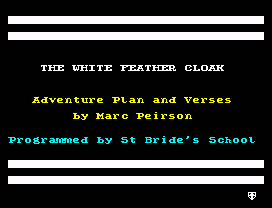 |
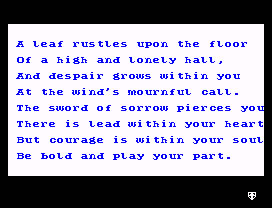 |
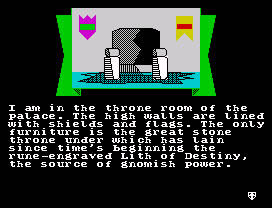 |
| (Above: The White Feather Cloak for ZX Spectrum 48K. Also planned for Amstrad CPC and C64 but it's unknown if those versions were ever started.) | ||
So, why did the three games never get released? Perhaps it was a mixture of bad timing, the changing marketplace, and potential publishers dealing with their own issues; Starlight and Destiny Software were both relatively short-lived ventures.
An article from the December 1987 issue of Your Computer magazine predicted that, "...unfortunately for Starlight, the label releasing the game, White Feather Cloak is likely to be overshadowed by the new St. Bride's adventure to be launched on CRL, Jack the Ripper."
That does seem to be the case and that is a shame as the White Feather Cloak, along with The Dogboy and Silverwolf, are in my opinion much more accomplished and interesting games, and much better examples of the work of St. Bride's.
There are plenty of unanswered questions left about the history of the games. The next obvious person to talk with was Francis Lee, formerly of Beyond, Starlight, and Destiny Software, to see if he could shed more light on matters.
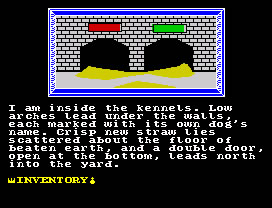 |
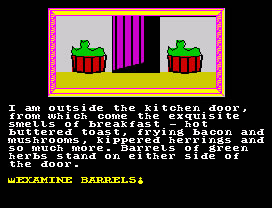 |
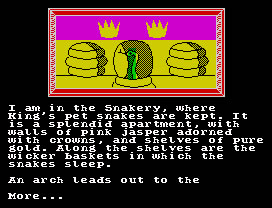 |
| (Above: The Dogboy, described as "a delightful, beautifully written game, that speaks to the child in all of us" by Terri Sheehan at the solution site CASA.) | ||
Francis Lee...
Thanks to Richard Hewison, I was able to get in touch with former Destiny boss, Francis Lee in early April 2021.
Francis wrote: "Please excuse my delay in getting back to you. As you will no doubt have seen from the website, things are very busy indeed with my creation Tales of Midnight. There has never been a better time for anyone developing a superhero franchise, so this is a very exciting period for me."
"I will try to address the issues raised in your email but in all honesty, much of what you seek is hidden in the mists of time, as my memory of that period with the ladies of St Bride's is very hazy. I can tell you that the overriding memory of the two or three meetings that I had with Miss Scarlet and Miss Langridge were the elaborate Victorian clothes they wore ... and the fact that Miss Langridge wore a veil throughout our encounters, which made it very difficult to see her features."
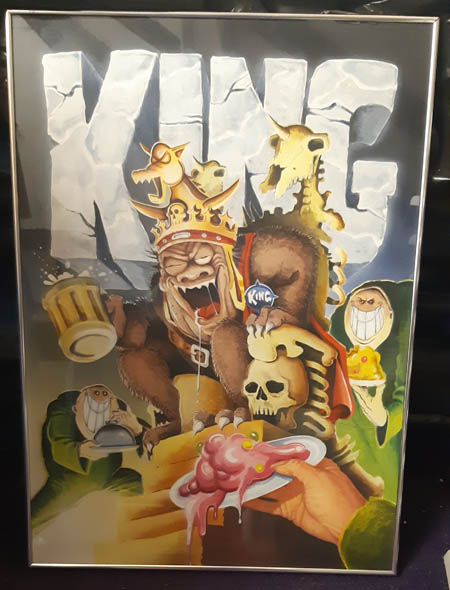 |
| (Above: The artwork commissioned for the planned Destiny release of King. Image & artwork copyright Francis Lee) |
"There was a cross over between the time the software label I was publisher of was being distributed through Ariolasoft at which point The White Feather Cloak was due to be published but I left that label to form my own new software company called Destiny. That company had my games Diamond, Yeti and Teladon initially distributed through Activision. However, I was approached by a company called Big Apple who wanted to secure a licensed deal with me for all my future game releases through Destiny the first of which was to be The Bobby Yazz Show and one of the future releases was to be the game King, which I had agreed to publish."
"Unfortunately, Big Apple was part of a much larger group that owned companies like Elkie Brooks label Legend Records and Big Apple went through a tumultuous phase when its parent company decided it was time for a management buyout, to focus on the core activities of the company and divest itself of its smaller divisions like Big Apple."
"That whole period was conducted in a less than open manner over the preceding months, with much of the behind-the-scenes buyout negotiations being kept from me and so Destiny had gone ahead in good faith producing games for Big Apple despite not getting the contractually obliged payments that were due, being told that vast delays in payments were due to accounting procedures being slow due to the size of the company and its many invoices that needed processing."
"By the time it was finally clear what was actually happening, that Big Apple was going to cease operations, it was too late to try to find alternative marketing and distribution for the games. That all led ultimately to Destiny ceasing trading which left many games unpublished."
"I am afraid that is pretty much all I can recollect from that period. I do however still have the artwork that I commissioned for the game King as it would have appeared on the game packaging. So I have attached it here for you to use, with the proviso that you credit it as copyright FRANCIS LEE."
Many thanks to Francis Lee for allowing us to share the artwork from King and for very kindly taking the time to talk about his days in the computer software industry.
What happened to GI Games...?
Well, the label didn't much longer than a year. Gordon Inglis found he needed to concentrate on his other business ventures and so (after a brief period of sub-licensing the games to other mail-order companies such as Zenobi, The Northern Underground, and VentureSoft) the publication rights were permanently passed on to John Wilson of Zenobi Software who ensured, at least, that the games were accessible to the small, but loyal, community of gamers still interested in text adventures at that time.
My thanks go to... Marc Peirson, Francis Lee, Richard Hewison, Tim Gilberts, StooB, Mocagh, The British Record Shop Archive, Discogs.com, CASA, Archive.org, GtW, & Spectrum Computing for their archives & help researching this article.
(Page created 28/03/21 - Updated 02/04/21, 03/06/21)
|